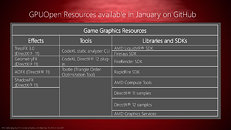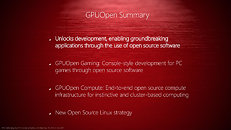Wednesday, December 16th 2015

AMD Counters GameWorks with GPUOpen, Leverages Open-Source
AMD is in no mood to let NVIDIA run away with the PC graphics market, with its GameWorks SDK that speeds up PC graphics development (in turn increasing NVIDIA's influence over the game development, in a predominantly AMD GCN driven client base (20% PC graphics market-share, and 100% game console market share). AMD's counter to GameWorks is GPUOpen, with the "open" referring to "open-source."
GPUOpen is a vast set of pre-developed visual-effects, tools, libraries, and SDKs, designed to give developers "unprecedented control" over the GPU, helping them get their software closer to the metal than any other software can. The idea here is that an NVIDIA GameWorks designed title won't get you as "close" to the metal on machines such as the Xbox One and PlayStation 4, or PCs with Radeon GPUs, as GPUOpen. Getting "close to the metal" is defined as directly leveraging features exposed by the GPU, with as few software layers between the app and the hardware as possible.AMD plans to put its GPUOpen resources on GitHub as early as January 2016, with its very own portal. This will give developers access to open-source content (stuff that they can implement in their own projects with as little legal voodoo as possible, blog-posts.
GPUOpen is a vast set of pre-developed visual-effects, tools, libraries, and SDKs, designed to give developers "unprecedented control" over the GPU, helping them get their software closer to the metal than any other software can. The idea here is that an NVIDIA GameWorks designed title won't get you as "close" to the metal on machines such as the Xbox One and PlayStation 4, or PCs with Radeon GPUs, as GPUOpen. Getting "close to the metal" is defined as directly leveraging features exposed by the GPU, with as few software layers between the app and the hardware as possible.AMD plans to put its GPUOpen resources on GitHub as early as January 2016, with its very own portal. This will give developers access to open-source content (stuff that they can implement in their own projects with as little legal voodoo as possible, blog-posts.





31 Comments on AMD Counters GameWorks with GPUOpen, Leverages Open-Source
You could get some developers ramping in too many or conflicting effects without the required QC. Gameworks, laughably ironic, benefit is support in development, can AMD offer the same?
Regardless, I can see the draw for devs, given the hardware inside all consoles. Just hope its utilised well and if it is and it hamstrings Nvidia, well, that'll be an interesting 'poo storm'.
We still have to remember that pc gaming is the underdog in the gaming world, and since AMD have 100% consoles then it might fly faster than any of us really think which means gameworks will be left behind in the dust, just like Nvidias Physx.
CPU physics took a while but since it works the same on all CPU's, games like Half-Life 2 could use it for puzzles or just more realistic feel of the entire game (floating corpses and objects, zombie splitting and fragmentation, ragdolls, objects collision and friction etc). PhysX on the other hand is only accelerated by one type of GPU (NVIDIA). Meaning developers cannot and will not afford losing customers by creating a NVIDIA only game. Especially not today when AMD is holding 100% of the console market. Meaning physics won't evolve anywhere. However, since GPUOpen is open and runs on all GPU's, we might see a breakthrough. We might see new unique games where physics are game's core element. Something you can't create with CPU physics.
Though, engine itself can provide such framework by itself and be fully independent. Unreal Engine has bunch of stuff that helps you create content faster (like terrain and props manipulation). Stuff like HairWorks or TressFX is even further more specific feature.
Imagine these frameworks as modules that you add to a core functionality. It's easier to add pre-made modules than build them from ground up from scratch. That's why they exist.
once the bullet 3 gpu pipeline hits a stable state we will finally have a completely opensource alternative to gamesometimesworks.
i just hope developers start to use this, integration into a ready engine like ue4 or pyrogenesis could get the ball moving in the right direction
There are developers who develop frameworks such as "Unity", "Unreal" etc. (most are multi-platform, including Xbone, PS4 where CGN reigns supreme)
Most of the other developers just use what guys mentioned above have developed. They don't really go too deep into "to the metal" levels.
The best part of this initiative is that it could be supported on nVidia, also barring proprietary "let me leverage my market position" things like Gameworks.
That being said, it needs a major kick in the pants to get moving, so they need to throw some hardware at people to ensure that some community devs will use it and get some awesome payback for it. Make X demo or game on any GPU and we will give you a new free GPU for the next two generations as long as your project works and source code is made available for others to build on.
FUSION= APUs, since AMD put they on the market, Intel increased their R&D on GPUs thorough the roof.
Bulldozer= Focus on multi thread computing, maybe not the best IPC, but does what promises for really affordable price point.
Mantle= Low level access for GPUs, without Mantle theres is no DX12 or Vulkan.
Fiji= Introduction to HBM, Fury X was meant to be on top of the GTX 980, if Nvidia released the 980ti 2 weeks after the FuryX, the asking price would be lower ($550~600, just like the R9 290X).
opensource myth must die??? Are crazy? Do you understand what are you saying? No comment here.
Look man, tell me, why you buy Nvidia cards?
*The best value card on the high end market right now is the 390X, nV offers are overpriced.
*AMD cards output higher color bits, Radeon HDRI/HDR engine is by Native 128bit, but nV is 24bit.
*D3D11 rendering on AMD cards is true 32bit. since the GTX700 nV only uses 24bit.
*AMD have all around better optimized AA, nV FXAA is a joke.
*FreeSync Monitors are more cheap and deliver a better result, and you have choice, Gsync begs for you to turn on Vsync in your games, instead AMD give you a frame limiter that don`t mess with your input lag.
*nV don`t care about VR, AMD develop and support LiquidVR.
*AMD don`t release 3.5Gb +500Mb cards and advertise like it has a full 4GB (GTX970 I am looking at you).
*AMD don`t release drivers to lower performance on older cards just to promote the new line up.
*And they sure don`t release and promote proprietary code that crash games (GameWorks)
*But nVidia does great things to!
So put some faith on the AMD guys, they are apparently the only ones pushing PC gaming forward or they have a really good PR department.
I applaud AMD, again, for doing the right thing.
@Aquinus, actually, in Arkham Knight, for instance, you can turn every one of the elements off or on individually for the Gameworks package. The settings even point out which are Gameworks. Turning them all off except for the special light rays is what allowed me to crank up the settings and play the game smoothly without a crash.
Mantle was a significant change from their past attempts, as was TressFX, and frame control tech. I hope they continue, for their own sake, many of us have long memories and are tired of getting crapped on with their failed attempts.